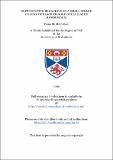Files in this item
Reproductive behaviour in a small inland colony of black-headed gulls (larus ridibundus)
Item metadata
| dc.contributor.advisor | Whiten, Andrew | |
| dc.contributor.author | McCulloch, Fiona M. | |
| dc.coverage.spatial | 260 p. | en_US |
| dc.date.accessioned | 2018-07-06T13:56:19Z | |
| dc.date.available | 2018-07-06T13:56:19Z | |
| dc.date.issued | 1990 | |
| dc.identifier.uri | https://hdl.handle.net/10023/15061 | |
| dc.description.abstract | This study was carried out over three breeding seasons at a small marsh-nesting black-headed gull (Larus ridibundus) colony. Two of the years proved to be atypically hot and dry, resulting in the drying out of parts of the colony. This facilitated predation by foxes and resulted in almost complete breeding failure in these two years. Synchronisation of breeding was evident but the average clutch size was smaller than generally recorded for black-headed gulls. There was a tendency for third laid eggs and third hatched chicks to have the highest mortality rate, and third hatched chicks put on less weight during their first three days of life than all other chicks. Pairs of gulls that did not successfully retain their territories and lay eggs spent less time on the territory than those that were successful. The unsuccessful males were also more restless and more aggressive than successful males. In general, the gulls spent most time on the territory during the incubation stage, although partners spent the most time together on the territory during the pre-egg stage. The territory was never left unattended during the incubation stage, but it was occasionally deserted during the pre-egg stage, and increasingly deserted as the chick stage proceeded. In one year, but not another, males spent most time on the territory and incubating during the egg stage, while females spent most time on the territory and brooding during the chick stage. The gulls were most aggressive during the pre-egg stage and least aggressive during the incubation stage, and the males played the greater role in defence during the pre-egg and egg stages. The sexes shared equally the feeding of the chicks and became less eager to feed the chicks as they grew. The number of feeds given per hour per chick decreased with increasing brood size. | en_US |
| dc.language.iso | en | en_US |
| dc.publisher | University of St Andrews | |
| dc.subject.lcc | QL696.C46M3 | en |
| dc.subject.lcsh | Black-headed gull--Behavior | en |
| dc.title | Reproductive behaviour in a small inland colony of black-headed gulls (larus ridibundus) | en_US |
| dc.type | Thesis | en_US |
| dc.contributor.sponsor | Science and Engineering Research Council (SERC) | en_US |
| dc.type.qualificationlevel | Doctoral | en_US |
| dc.type.qualificationname | PhD Doctor of Philosophy | en_US |
| dc.publisher.institution | The University of St Andrews | en_US |
This item appears in the following Collection(s)
Items in the St Andrews Research Repository are protected by copyright, with all rights reserved, unless otherwise indicated.

